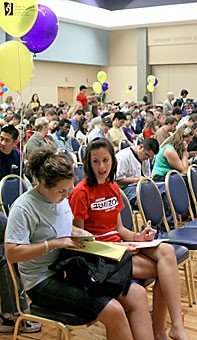Smaller, less organized clubs suffer from a vicious cycle of few members and low participation, according to a club adviser.
Sometimes, new clubs starting out don’t have the information needed to keep a club going, said Heather Gasser, assistant director of undergraduate initiatives for the department of multicultural programs and services, and adviser for BabyCats.
Poor succession planning also hinders club progress when club leaders lose interest or graduate, Gasser said.
The Center for Student Involvement and Leadership should check in with clubs in the spring semester and see if they’re planning for succession of new leaders, Gasser said.
“”CSIL has leadership workshops and conferences,”” Gasser said. “”But they don’t have much with regard to targeted services for leaders.
The Associated Students of the University of Arizona and the Graduate and Professional Student Council offer funding to student clubs. Clubs can receive up to $5,000 for on-campus events, up to $2,500 for competitive events and up to $500 each for travel expenses and capital from ASUA.
In spite of the available funds, new clubs often fail within a year, raising the question of whether money has been put to good use, Gasser said.
Chris Bischof, a history junior and president of Geniuses of Diversity: Atheists, Agnostics, Deists and Freethinkers, said lackluster membership is not ASUA’s fault. Rather, it can be blamed on student apathy.
Dorana Lopez, an economics senior and former president of BabyCats, said she doesn’t think it’s always a lack of interest.
“”One of the major reasons it’s hard to get members to volunteer is lack of time,”” Lopez said.
Members of the clubs are scared to volunteer because they “”barely have time to do homework,”” Lopez said.
Recruitment of new members is key, club leaders said.
“”I think for a club to be successful, you need to have student investment in the longevity of the club,”” Gasser said.
Bischof said he is looking for another person to take a more active role in Geniuses of Diversity because he was recently named president of another campus club.
Magna Mentoring Project, a club dedicated to mentoring underprivileged high school students in the college and scholarship process, talks to honors and education students in hopes of gaining new membership, said Casey Edwards, a sophomore majoring in Spanish and co-president of the organization.
Magna Mentors, which has seven members, isn’t able to expand mentoring to more high schools, Edwards said.
“”Right now, we’re such a small project, we wouldn’t have the resources to do that,”” she said.
While tuition rates and class selection are important factors in student retention at the university, a big part of it is engagement on campus, which means activities and clubs, Gasser said.
“”When you do meet other folks (with similar interests), it’s kind of nice to make a connection,”” Gasser said.









